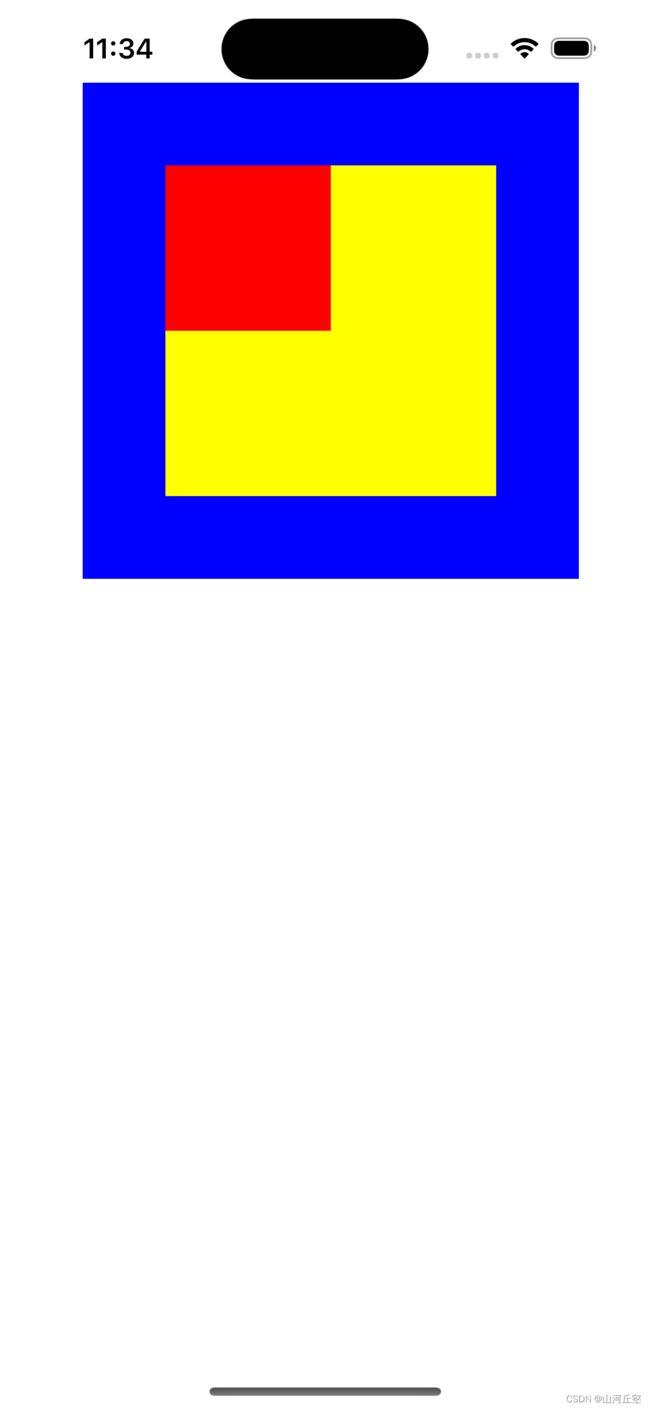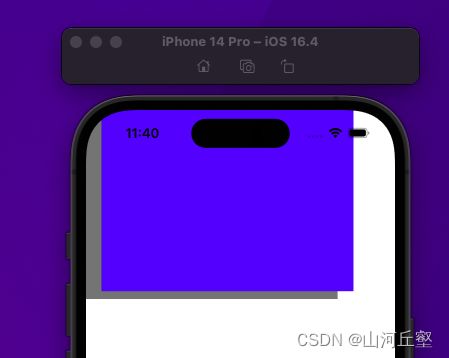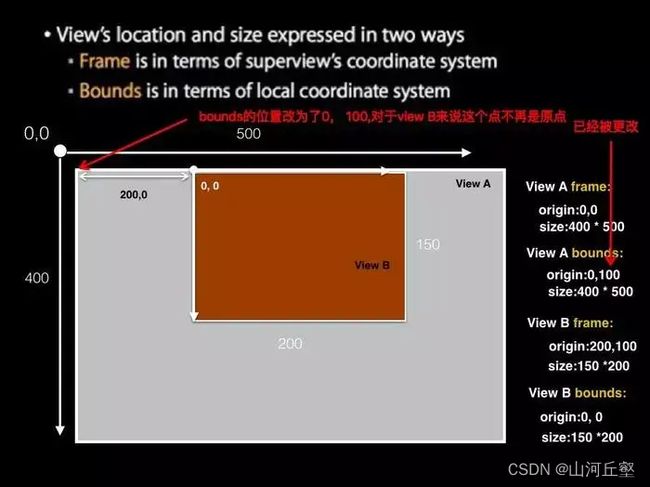iOS--frame和bounds
坐标系
首先,我们来看一下iOS特有的坐标系,在iOS坐标系中以左上角为坐标原点,往右为X正方向,往下是Y正方向如下图:

bounds和frame都是属于CGRect类型的结构体,系统的定义如下,包含一个CGPoint(起点)和一个CGSize(尺寸)子结构体。
struct CGRect {
CGPoint origin;
CGSize size;
};
origin决定了view的起点,size决定View的尺寸。
frame
frame是每个view必备的属性,表示view在父view坐标系统中的位置和大小,参照点是父视图的坐标系统。
示例代码:
UIView *viewA = [[UIView alloc] initWithFrame:CGRectMake(50, 50, 300, 300)];
[viewA setBackgroundColor:[UIColor blueColor]];
[self.view addSubview:viewA];
NSLog(@"viewA - %@",NSStringFromCGRect(viewA.frame));
UIView *viewB = [[UIView alloc] initWithFrame:CGRectMake(50, 50, 200, 200)];
[viewB setBackgroundColor:[UIColor yellowColor]];
[viewA addSubview:viewB];
NSLog(@"viewB - %@",NSStringFromCGRect(viewB.frame));
UIView *viewC = [[UIView alloc] initWithFrame:CGRectMake(100, 100, 100, 100)];
[viewC setBackgroundColor:[UIColor redColor]];
[self.view addSubview:viewC];
NSLog(@"viewC - %@",NSStringFromCGRect(viewC.frame));


以上可以看出,viewB和viewC的起点重合,但是从打印结果来看,viewB的起点为(50,50),而viewC的起点为(100,100)。原因就是frame中的位置是以父视图的坐标系为标准来确定当前视图的位置,viewB的父视图为viewA,viewC的父视图为self.view,而由于viewA的起点为(50,50),所以viewB与viewC起点才会重合。
bounds
UIView *viewA = [[UIView alloc] initWithFrame:CGRectMake(50, 50, 300, 300)];
[viewA setBackgroundColor:[UIColor blueColor]];
[self.view addSubview:viewA];
NSLog(@"viewA - %@",NSStringFromCGRect(viewA.bounds));
UIView *viewB = [[UIView alloc] initWithFrame:CGRectMake(50, 50, 200, 200)];
[viewB setBackgroundColor:[UIColor yellowColor]];
[viewA addSubview:viewB];
NSLog(@"viewB - %@",NSStringFromCGRect(viewB.bounds));
UIView *viewC = [[UIView alloc] initWithFrame:CGRectMake(100, 100, 100, 100)];
[viewC setBackgroundColor:[UIColor redColor]];
[self.view addSubview:viewC];
NSLog(@"viewC - %@",NSStringFromCGRect(viewC.bounds));

bounds也是每个view都有的属性,这个属性我们一般不进行设置,表示view在本地坐标系统中的位置和大小。参照点是本地坐标系统。如果我们对上例打印bounds,将会得到以下结果:

因为我们并没有设置bounds值,那么,bounds到底有什么作用呢。这里强调,每个视图都有自己的坐标系,且这个坐标系默认以自身的左上角为坐标原点,所有子视图以这个坐标系的原点为基准点。bounds的位置代表的是子视图看待当前视图左上角的位置,bounds的大小代表当前视图的大小。原则如下:
更改bounds中的位置对于当前视图没有影响,相当于更改了当前视图的坐标系,对于子视图来说当前视图的左上角已经不再是(0,0), 而是改变后的坐标,坐标系改了,那么所有子视图的位置也会跟着改变。- 更改bounds的大小,bounds的大小代表当前视图的长和宽,修改长宽后,中心点继续保持不变, 长宽进行改变,通过bounds修改长宽看起来就像是以中心点为基准点对长宽两边同时进行缩放
两者的区别
origin的区别
此时,如果我们把ViewA的bounds改为(0,100),结果如下:
我们始终要清楚,bounds的位置代表的是子视图看待当前视图左上角的位置。 bounds遵守的原则一中,更改bounds中的位置对于当前视图(ViewA)没有影响,相当于更改了ViewA的坐标系,但是子视图(ViewB)不同,对于ViewB来说ViewA的左上角已经不再是(0,0), 而是(0,100),所以对于ViewB来说,ViewA坐标系的原点其实是在红色箭头所指处的上方100处,而此时ViewB的frame.origin为(200,100),所以ViewB的上边与ViewA上边重合。
如果我们更改ViewA的bounds为(200,0),同理(可以自己思考试试),结果如下

size的区别
frame的size直接决定了view的大小,而bounds的size修改后,view的中心点不变,长宽以中心点进行缩放
UIView *viewA = [[UIView alloc] initWithFrame:CGRectMake(0, 0, 320, 240)];
[viewA setBackgroundColor:[UIColor grayColor]];
[self.view addSubview:viewA];
UIView *viewB = [[UIView alloc] initWithFrame:CGRectMake(100, 50, 160, 120)];
[viewB setBackgroundColor:[UIColor blueColor]];
[viewA addSubview:viewB];
//viewB设置size(320,160)
[viewB setBounds:CGRectMake(0, 0, 320, 240)];
设置了size之后的结果,viewB左上点距离viewA显然不为(100,50),而是进行了基于viewB视图中心点的缩放操作
总结
- frame不管对于位置还是大小,改变的都是自己本身。
- frame的位置是以父视图的坐标系为参照,从而确定当前视图在父视图中的位置。
- frame的大小改变时,当前视图的左上角位置不会发生改变,只是大小发生改变。
- bounds改变位置时,改变的是子视图的位置,自身没有影响;其实就是改变了本身的坐标系原点,默认本身坐标系的原点是左上角。
- bounds的大小改变时,当前视图的中心点不会发生改变,当前视图的大小发生改变,看起来效果就像缩放一样。

